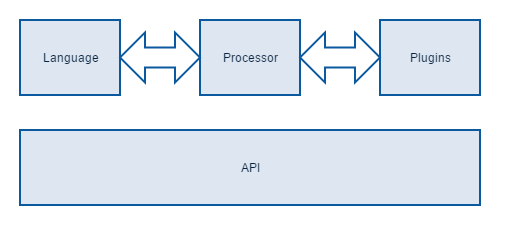Getting Started
In this chapter we will take a look at an overview of the Xill platform and what components it consists of. This way we can gain a better understanding of what the responsibility of the plugin is and how we can maximize its potential.
Components of Xill

At the core of Xill is a modular framework with modules that have clear responsibilities.
Language
The language module defines the Xill syntax converts scripts to token trees. These trees contain all tokens required for processing. This module does no processing other than syntax and sanity checking of the scripts.
Processor
The processor module is where the magic happens. This module executes scripts. It will take a syntax tree and parse it to a processable object. It manages all resources and handles errors and debugging.
API
The API contains all shared classes. This module provide a shared interface for plugins to talk to. It contains essential classes like the MetaExpression and all the shared data types like XML, Date and more.
Plugins
Now this is what this guide is about. The plugins add actual functionality to Xill. They allow calls to other Java libraries or perform specific operations. These plugins consist of a collection of constructs available to the Xill programmer.
A construct in Xill is a function that takes a fixed amount of expressions as input and performs a specific operation. All these constructs can communicate with each other in their own sandbox inside the plugin package. This means the will not affect constructs in other plugins.
Note: For the more experienced Java developers, when we talk about a sandbox what we really mean is that the plugins have their own class loader.
Xill processor module manages these plugins.
use System;
// In this case `System` is a plugin package.
// And System.print is a construct.
System.print("Hello World");
What Makes a Plugin
Let's take a more detailed look at the things a plugin contains. We saw earlier that it contains a package and some constructs, but there is a little bit more to it than that. If you want to know how to set up these specific parts then skip to Developing a Plugin.
Package Declaration
The first part of a plugin is its package declaration. This declaration specifies where the Processor can find the plugin so the framework can load it. If you use our maven build this declaration will be automatically generated.
Package Implementation
The second part is the actual implementation of the package. This implementation is the class referenced by the package declaration and must be a subclass of the XillPlugin class.
Constructs
Now strictly speaking we do not need constructs to form a plugin but without any your plugin will be boring. These constructs are implementations of the abstract Construct class. They provide a way for the processor module to perform any operation. The package implementation loads them and keeps in the same sandbox as the other constructs in that package.